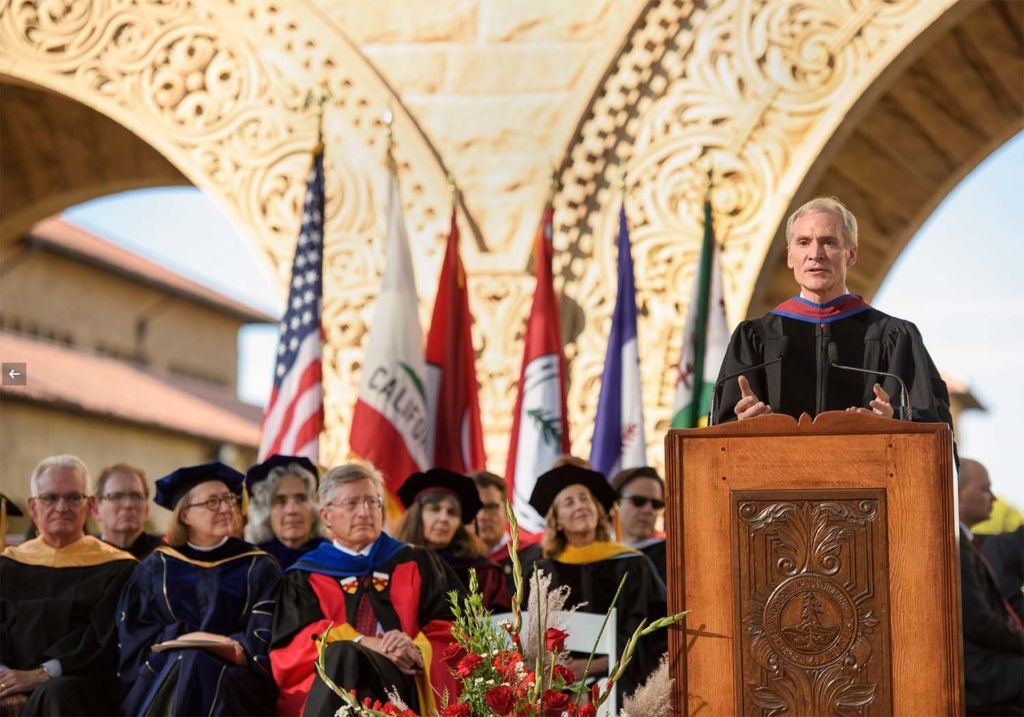Stanford’s Convocation welcomes new students and transfers
At the 126th Opening Convocation Ceremony held in the Inner Quad Courtyard on Tuesday, Stanford President Marc Tessier-Lavigne drew inspiration from an 1891 address university co-founder Jane L. Stanford wrote for the very first class of incoming students.
“She wrote: ‘There is only one failure for you and that is not to be true to the best you know,’” he said. “So I urge you to take that to heart: Be true to the best you know.”
Tessier-Lavigne said one of the greatest gifts Stanford will bestow on new students will be exposure to people from diverse backgrounds and to people with diverse points of view.
“As a result, you will be challenged by new ways of looking at the world that may be different than your own – often very different,” he said.
“Freedom of expression is one of the values we hold highest here, along with the importance of a community where everyone feels included and respected. The fact that we don’t shirk from addressing difficult issues, but that we do so in mutual understanding and respect, provides a powerful opportunity for you to examine humanity from all sides.”
Tessier-Lavigne was one of several speakers who welcomed new students and their families and friends to Stanford during Convocation, which inaugurates the new academic year. The speakers encouraged Stanford’s newest crop of scholars to get the most out of their university experience by taking chances, trying new things and not holding back.
Tessier-Lavigne, who took office Sept. 1 as Stanford’s 11th president, urged students to learn about anything and everything, since they may not know yet what will inspire them.
“When I started college I was sure I would be a mathematician or physicist, but I got exposed to philosophy and to biology, and now, 30 years later, I’ve built my career around neuroscience,” he said. “You also don’t know what might be helpful to you in the future. There’s a famous tale of Steve Jobs taking a calligraphy class on a whim, only to find years later that it helped him revolutionize desktop printing.”
Tessier-Lavigne encouraged students to “stretch themselves” by signing up for something that intrigues them – something a little beyond their comfort zones.
“When I was in college, I wanted to join the student newspaper but I lacked confidence about my writing, so I joined as a photographer, and only eased into writing over time with the support of other students,” he said. “It remains one of the fondest memories of my time in college, and the skills I learned have been really important to my later career, including giving speeches like this one.”
Tessier-Lavigne told students not to lose sight of the fact that they were enrolled in a great research university that offered opportunities not available at other schools.
“Undergraduates can engage in research in the museum, the field and the laboratory – and those opportunities include the arts, the humanities and social sciences, as well as the sciences and engineering,” he said.
Tessier-Lavigne also encouraged students to make a commitment to public service – on and off campus – through Cardinal Service and become part of a longstanding Stanford tradition of making a difference in the world.
He urged students to be optimistic and confident in their abilities.
“College can seem overwhelming at times, but we know you have what it takes to get the most out of it,” he said.
Read the full story in Stanford Report.
See the slideshow of move-in day.
See the video of move-in day.

